

|
In today's October 15, 2009 newsletter . . .
Your Fitness NotebookKeeping a fitness notebook provides order and efficiency to your workouts and your life. A simple three-ring binder and some index tabs work fine. Keep it simple, but keep it current.Goals Some people even tape their goals list on a wall or mirror so they see them every day. If it helps, do it. Whenever you reach a short-term goal, check it off the list, and write in the actual date you reached it. Incrementally, you are closing in on your long-term goals. Once you reach a long-term goal, set a new one. Keep repeating the process. Structured goal setting is a "secret" tactic of many successful people. Vital statistics
Also, measure your arms (flexed), chest (filled), waist (normally relaxed), hips, and thighs. If you are a beginner, work up the courage to put on a pair of shorts and take a "before" picture. Paste it on the page along with your measurements. Every 90 days, add a new page with updated information. (Most people are not going to have a cholesterol test every 90 days. However, if you have a serious cholesterol problem, ask your doctor how often it should be checked.) Workout Record Always go into the gym with a written workout plan. Between sets, make notes about raising or lowering the weight or reps at your next workout. Put the page in your notebook. When you write out your next workout, make the weight or reps adjustments according to your notes. If you train at a health club, you’ll see some people changing exercises at random. Some experienced bodybuilders train intuitively, successfully arranging and rearranging as they go along. But until you have plenty of experience to draw on, I don't recommend it. Without a formal plan, beginners become ships without rudders. So keep a current exercise log. When you change your routine (monthly), keep the first and last pages from the previous month and toss out the rest. That way, you’ll have a month-to-month record of where you began and where you finished. Keep repeating the process.
Arnold Press and Dumbbell CurlThe Arnold Press was a favorite of California's governor during his Muscle Beach days. He liked to start the press with his palms facing him, and as the weights were pressed overhead they rotated to face forward. He would retrace the movement in the reverse coming down.I've added two things. From what I've seen in photos, the governor pressed the dumbbells while seated. He was using huge weights and probably wanted to concentrate entirely on his shoulders. I like to do them standing. It forces me to keep my core tight, as it should be when doing any kind of overhead pressing. The second thing I've added to the movement is a biceps curl. So the movement goes as follows: curl, press, return. Curl, press, return. Watch the video and few times before trying it. And of course it can be done either seated or standing. I prefer standing for the reason given above. I think you'll find that it's a nice upper-body combination movement that flows well, while working biceps, triceps, and shoulders. As always, don't hold your breath. Get a comfortable inhale-exhale rhythm going. You've probably heard about the tremendous benefits of weight training and how you can retain -- or even reclaim -- the attributes of youth . . . Discover the way with . . . Gray Iron: A Fitness Guide for Senior Men and Women The Gray Iron Fitness Newsletter is a free publication sent twice monthly to our subscribers. Our purpose is to provide honest and realistic fitness information for people age 50 and above. Always consult with your physician before making dietary changes or starting an exercise program. Your comments or questions are always appreciated. Sincerely, Logan Franklin |
